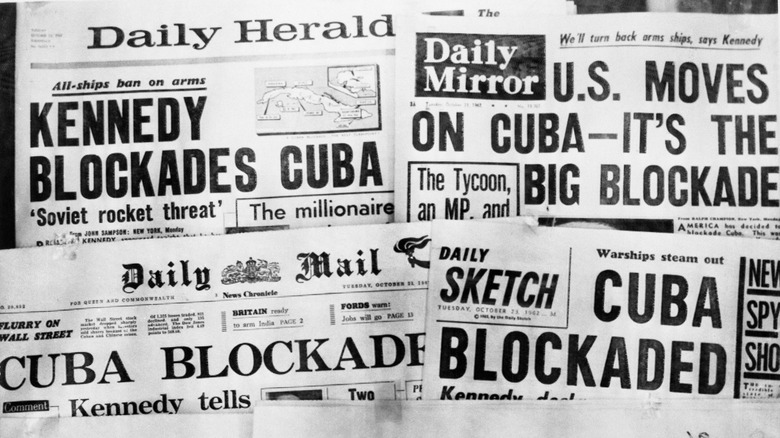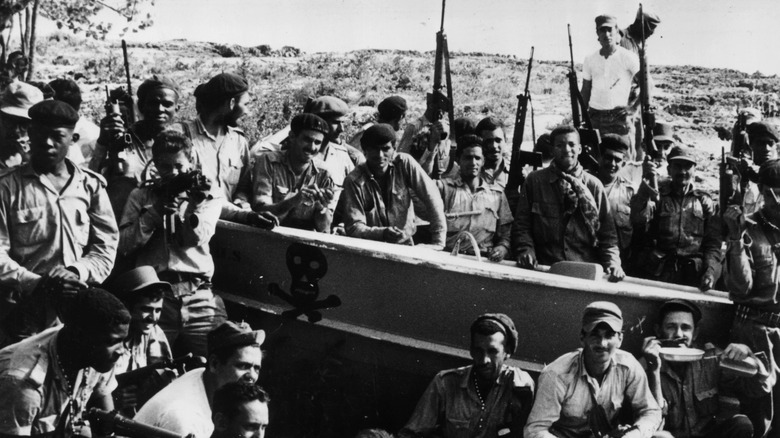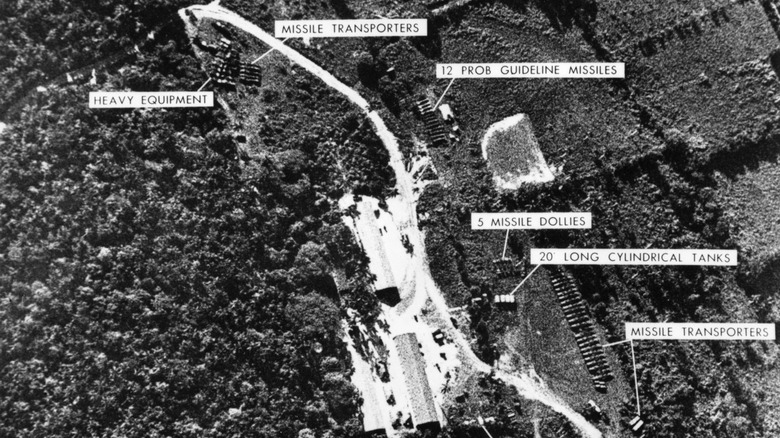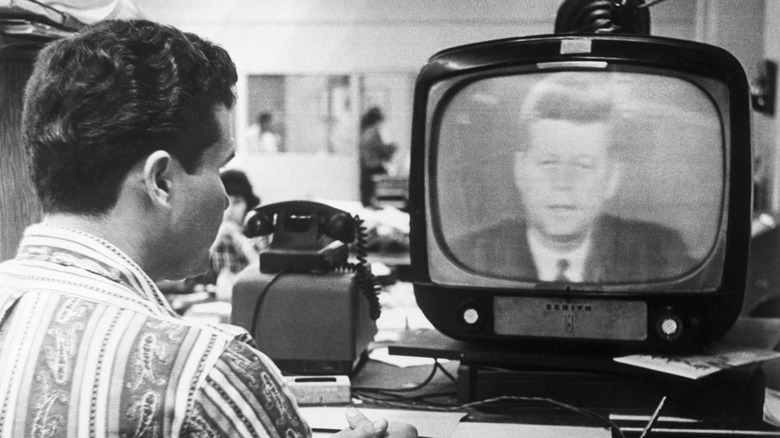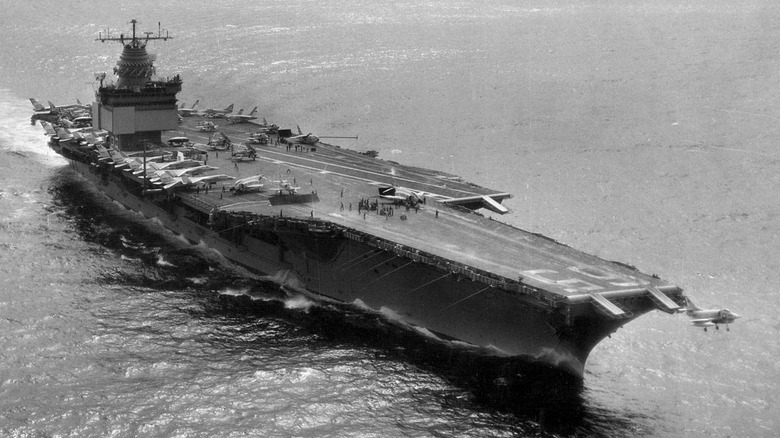How The U.S. Snuck Aircraft Carriers Across The Ocean During The Cuban Missile Crisis
The Cuban Missile Crisis occurred over 13 unnerving days in October 1962 and brought the U.S. and Soviet Union alarmingly close to the precipice of a full-scale nuclear war. But to understand how and why the United States needed to sneak aircraft carriers across the ocean to deal with this crisis in the first place, we need to know what led up to the crisis.
In 1933, a young Cuban army sergeant named Fulgencio Batista led a rebellion that overthrew then-president Carlos Manuel de Céspedes. For the better part of the next three decades, Cuba was ruled by puppet presidents or engaged in some form of coup d'états, with Fidel Castro and his 800 guerrilla warriors forcing Batista to flee the country at the start of 1959.
Like many of Cuba's leaders in the past, he promised one thing but delivered another. Instead of freedom and opportunities, Castro nationalized private-sector commerce and began an anti-U.S. campaign. The economy soon tanked, turning the people against him. When Castro established a trade agreement with the Soviet Union in February 1960, the United States had no choice but to take action. President Dwight D. Eisenhower tasked the Central Intelligence Agency (CIA) with figuring out a way to invade Cuba and oust Castro by any means necessary, which even included outright assassination by way of poison and botulism pills.
The Bay of Pigs further escalated the crisis
When John F. Kennedy was elected president in November 1960, he agreed to continue Eisenhower's plan. With Cuba only 90 short miles off the coast of Key West, Florida, this alliance posed a serious problem. By the start of 1961, all official diplomatic relations with Cuba ceased, and on April 17, 1961, the debacle that was the Bay of Pigs invasion took place. It's considered one of many military operations that failed miserably throughout history.
The botched invasion had the opposite of its intended effect, and Castro ended up emboldened to publicly announced a path toward socialism and strengthen Cuba's alliance with the Soviet Union. The U.S., in turn, was forced to develop a new strategy, and Operation Mongoose (a continuation of Eisenhower's plan to remove Castro by any means necessary) was born.
Ultimately, this plan failed, too, with the relationship between Cuba and the Soviet Union actually growing stronger and arms shipments to Cuba increasing. Soviet Premier Nikita Khrushchev thought very little of Kennedy and believed the new and mostly ineffective President wouldn't do much to stop him, so he began sending ballistic cruise missiles to the island in May 1962. Fear quickly escalated within the Kennedy administration that the Soviets would soon start arming those missiles with nuclear warheads, giving the Russians a close-range first-strike tactical advantage over the United States.
Kennedy orders an ocean blockade against Cuba
On October 14, a U-2 spy plane — which the USAF is still flying today – flew over Cuba and snapped photographs of Soviet SS-4 Sandal medium-range ballistic missile (MRBM) launchers in various stages of construction. Initially, Kennedy didn't want the Soviets or Cubans to know that they knew about the missile sites, but after speaking with advisers, he decided to implement a total blockade of Cuba.
The goal was to keep Soviet ships — carrying supplies, parts, and equipment — from reaching Cuba, thereby stopping the construction of the missile sites. Furthermore, Kennedy called for the destruction of the sites already built and for the existing missiles to be removed immediately. Kennedy addressed the country via a live televised broadcast on October 22. In the days leading up to the broadcast, though, actions were already being taken to prepare for whatever might happen. Thankfully, Mother Nature and good old-fashioned timing would help the United States sneak aircraft carriers across the ocean toward the island hot spot.
Hurricane Ella first appeared far out in the Atlantic Ocean on October 14 and lasted 11 days. The hurricane meandered towards the U.S. but mostly stayed out to sea, then veered south along the Eastern seaboard toward the Bahamas and close enough to Cuba that the U.S. saw an opportunity to use it as an excuse to hastily move a host of naval ships into the region.
Kennedy sends aircraft carriers in to up defenses
On October 19, Atlantic Fleet Headquarters ordered the nuclear-powered aircraft carrier USS Enterprise to immediately set sail for the Naval Station in Guantánamo Bay, Cuba. As luck would have it, more than 40 ships, including the aircraft carriers USS Independence and USS Randolph, were part of a routine amphibious training exercise code-named "Quick Kick" that had already been scheduled for October 20, so this was used as an excuse to cover up their stealthy move toward Cuba. Similarly, the Atlantic Fleet publicly stated that its ships were moving due to Hurricane Ella, when it was really sending them to contribute to the blockade.
Just before Kennedy's address on Monday, October 22, the Joint Chiefs ordered all U.S. forces worldwide to move from Defense Condition (DEFCON) 5 to 3. The President went on air and informed the nation they had "unmistakable evidence" of Soviet interference in Cuba and that a blockade would take effect on October 24.
Additionally, Kennedy made it clear that any missiles launched from Cuba would be regarded as an attack by the Soviet Union, whether they were aimed at the United States or not. As his speech traveled the airwaves, several submarines — each packing a host of Polaris ballistic missiles — moved into strategic positions to better reinforce silo-based ICBMs (intercontinental ballistic missiles) and bombers. The world crept ever so closer to the edge of nuclear war.
The Cuban Missle Crisis ends peacefully
The day after Kennedy's address, three low-level reconnaissance missions were conducted using RF-8As — the single-engine recon version of the F-8 Crusader fighter (which would go on to have a huge role in the Vietnam War) – equipped with five high-altitude cameras. When the blockade officially began on October 24, Soviet Premier Khrushchev declared the move an "act of aggression" and vowed ships would continue unfettered to Cuba. The USS Randolph, flanked by other ships, acted as principal operating forces. Meanwhile, battlegroups led by the USS Enterprise and USS Independence cruised the waters south of the Windward Passage (between Cuba and Hispaniola).
Over the next few days, the world literally teetered on the edge of a nuclear war as the two sides went back and forth, testing who would budge first. Then, on October 27, two pivotal things happened. First, a Soviet General confirmed to the Kremlin that two salvoes of 36 medium-range ballistic missiles were operational and ready to fire on the United States. Second, a U-2 spy plane piloted by Major Rudolf Anderson Jr. that was flying recon over Cuba was shot down by Soviet SA-2 surface-to-air missiles (SAMs). Anderson was killed, and the plane was destroyed.
Both sides came to realize just how close they were to nuclear Armageddon and cooler heads prevailed. On October 28, Khrushchev agreed to dismantle and remove the missiles from Cuba, while Kennedy promised not to attack Cuba. Initially, Castro argued against the pact but eventually agreed.
